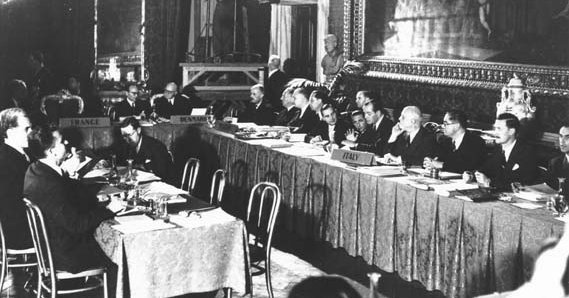The Council of Europe, temple of human rights
To fully understand this very little known institution, we need to go back to the end of the 1940s. A time when, Europe was economically, morally, politically and humanly destroyed following the worst war of its history. Contemporaries of this period had but one slogan “never again”. The unity of the European continent (which would later be “reduced” in the occidental part after the 1948 Czechoslovak coup d’état) became thus an emblem of reconstruction, in terms of the protection of fundamental human rights such as the right to life, democracy or the ban on torture.
The creation of the Council of Europe, by the 1949 Treaty of London, was the synthesis of federalist and intergovernmental logic. The unity of Europe was to be forged therefore by other means (for instance, the European Coal and Steel Community, and then the European Economic Area would take the reins in the quest for a supranational Europe). The protection of human rights and of democracy was therefore the only essential prerogative of the Council of Europe, founded by ten countries (France, Italy, the UK, the Republic of Ireland, the three Benelux countries and the three continental Scandinavian countries). The very first European organisation in history then adopted in November 1950 the Convention which safeguards human rights and fundamental freedoms and entered into force in 1953. This foundational text of human rights, written barely two years after the UN universal declaration of human rights, fitted into a global dynamic favouring peace, however at that same time the cold war started to begin with the conflict in Korea. The European Court of Human Rights (ECHR) was established in 1959 to assure a thorough application of the Convention. The latter has since evolved with the addition of protocols and today has five principal sections with 59 articles.
As a sign of its success, the ten founding members of the Council of Europe were progressively joined by the entirety of the democratic countries of Western Europe (Finland was the last non communist country to join, in May 1989). After the fall of the Berlin wall, membership to the Council of Europe (helped by the Venice Commission) was the very first step for the ex-USSR countries and people’s democracies towards a European integration, long before the EU and NATO. The organisation based in Strasbourg, France, counts today 47 members, covering the European continent in the large sense of the term (with the notable exception of Belarus).
The Council of Europe was therefore created around the binding protection of human rights. Just as for the EU, its administrative and political institutions ensure its successful functioning. At the top, there is the secretary general who is endowed with vast powers within the institution; the incumbent is Norwegian Thorbjørn Jagland. He assists the two principal mechanisms of the COE; the Council of Ministers (responsible for implementing the arrests made by the ECHR, amongst other things) and the Parliamentary Assembly (of which the 324 members must promote human rights but do not have the power to vote binding texts). The commissioner of human rights (currently the Latvian-American Nils Muižnieks) works independently within the Council of Europe, and also aims to promote such rights in the 47 member countries.
Despite its longevity and its successful expansions, the Council of Europe isn’t exempt from criticism. For instance, it seems incapable of fighting against authoritarian deviations of certain members such as Russia or Turkey, despite publishing numerous reports (the Council of Europe’s specialty). The Russian members of the Assembly no longer sit there since 2014, a sign of profound tensions between Strasbourg and Moscow.
The European Union, guarantor of economic freedoms (but not only)
Contrary to the Council of Europe, the ECSC and then the EEC (which became the EU in 1993) has always had essentially an economic significance (although not necessarily without an idealistic political aspect). The European Court of Justice of the European Union, created in 1952, affirmed the primacy of community law; stemming from national rights and economic freedoms within the framework of a common market (becoming later the single market). The freedom of movement of goods, workers, citizens, services and capital is a cardinal value of substantive law of the EU.
However, the economic freedoms extolled by the EU are not in total opposition with other fundamental freedoms. The proof is in article 6 of the EU treaty “The Union shall respect fundamental rights, as guaranteed by the European Convention for the protection of Human Rights and Fundamental Freedoms signed in Rome on 4 November 1950 and as they result from the constitutional traditions common to the Member States, as general principles of Community law”. The famous “rule of reason” is also applied in order to limit freedom of movement in case of a risk of life or health, amongst others. The member states and citizens can refer to the Court of Justice of the European Union if they deem that their rights have been abused by European institutions or by other states.
The social domain has been the forgotten industry of the EU, the traditions in this domain being very different from one country to another. The charter of fundamental rights of the EU was however signed during the 2000 Treaty of Nice. This text gathers together the civil and social rights which European citizens enjoy, spread out in six chapters and 54 articles. This charter was made binding by the Treaty of Lisbon in 2007. The Fundamental Rights Agency, based in Vienna, is for its part, dedicated to the fight against racism and xenophobia.
What is the relationship between the Court of Justice of the European Union and the European Court of Human Rights?
Despite being two distinct organisations; the Council of Europe and the European Union have forged ties, notably concerning the protection of human rights and fundamental freedoms. During the Treaty of Lisbon, the EU officially adhered to the European Convention of Human Rights and Fundamental Freedoms, which implies the Court of Justice of the European Union’s “acknowledgment” of the European Court of Human Right’s authority.
However, the Court of Justice of the European Union is very reluctant to recognise the de jure authority of the European Court of Human Right’s authority. Is this really necessary? The dialogue between the two courts is rich (what we also call “the dialogue of the European judges”) and beneficial for democracy despite a risk of divergent interpretations on fundamental rights.
The dialogue is necessary in any case, since all of the members of the EU are equally members of the Council of Europe. The ECHR could be taken advantage of for questions relating to the respect of fundamental rights in the framework of an application of European law. Tensions could, however, rise if the Court of Justice of the European Union had to acknowledge the formal authority of the European Court of Human Rights.




Follow the comments: |
|
